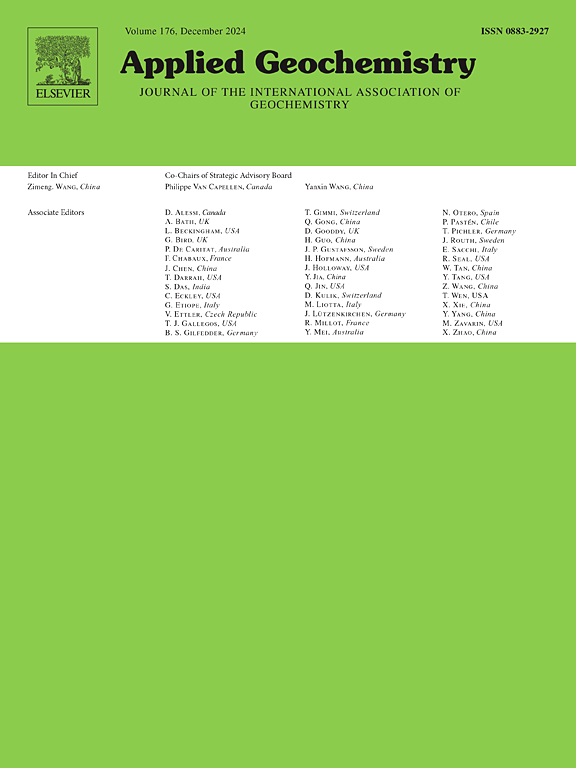The effect of bentonite colloids on sorption of Eu in crystalline rock and its minerals
IF 3.4
3区 地球科学
Q1 GEOCHEMISTRY & GEOPHYSICS
引用次数: 0
Abstract
This study examines Eu sorption on two Olkiluoto crystalline rocks and their minerals in low-salinity groundwater conditions. Sorption was studied as a function of 151EuCl3 molarity and pH. In addition, the competitive effect of MX-80 bentonite colloids on Eu sorption was examined. To understand Eu's behavior in different experimental scenarios, the factors influencing Eu sorption were further investigated by means of CEC, and zeta potential analysis of the materials used. The study revealed that the strongest sorbents for Eu under the defined conditions were biotite and biotite-rich heterogeneous metatexitic gneiss. Depending on the rock matrix used and the colloid concentration of the solution, the introduction of bentonite colloids as a competing agent significantly reduced the sorption of Eu on rock matrix. These findings provide insights into radionuclide mobility in natural and engineered systems.
膨润土胶体对结晶岩及其矿物中铕吸附的影响
本研究考察了两种奥尔基洛托结晶岩及其矿物在低盐度地下水条件下对Eu的吸附。研究了151EuCl3的摩尔浓度和ph对其吸附的影响,并考察了MX-80膨润土胶体对Eu吸附的竞争效应。为了了解不同实验条件下铕的吸附行为,通过CEC和zeta电位分析进一步研究了材料对铕吸附的影响因素。研究表明,在规定的条件下,Eu的最强吸附剂是黑云母和富含黑云母的非均质变质片麻岩。根据所使用的岩石基质和溶液的胶体浓度,引入膨润土胶体作为竞争剂显著减少了Eu在岩石基质上的吸附。这些发现提供了对自然和工程系统中放射性核素迁移的见解。
本文章由计算机程序翻译,如有差异,请以英文原文为准。
求助全文
约1分钟内获得全文
求助全文
来源期刊

Applied Geochemistry
地学-地球化学与地球物理
CiteScore
6.10
自引率
8.80%
发文量
272
审稿时长
65 days
期刊介绍:
Applied Geochemistry is an international journal devoted to publication of original research papers, rapid research communications and selected review papers in geochemistry and urban geochemistry which have some practical application to an aspect of human endeavour, such as the preservation of the environment, health, waste disposal and the search for resources. Papers on applications of inorganic, organic and isotope geochemistry and geochemical processes are therefore welcome provided they meet the main criterion. Spatial and temporal monitoring case studies are only of interest to our international readership if they present new ideas of broad application.
Topics covered include: (1) Environmental geochemistry (including natural and anthropogenic aspects, and protection and remediation strategies); (2) Hydrogeochemistry (surface and groundwater); (3) Medical (urban) geochemistry; (4) The search for energy resources (in particular unconventional oil and gas or emerging metal resources); (5) Energy exploitation (in particular geothermal energy and CCS); (6) Upgrading of energy and mineral resources where there is a direct geochemical application; and (7) Waste disposal, including nuclear waste disposal.
 求助内容:
求助内容: 应助结果提醒方式:
应助结果提醒方式:


